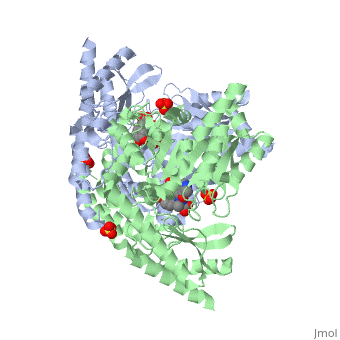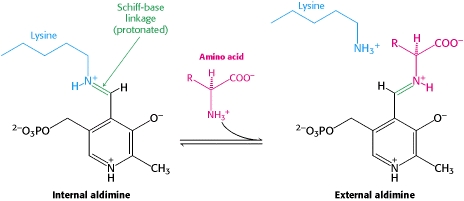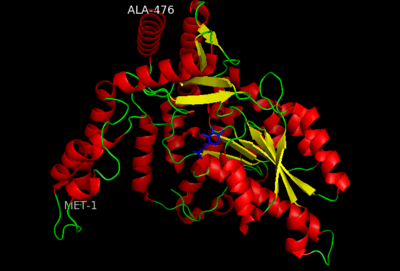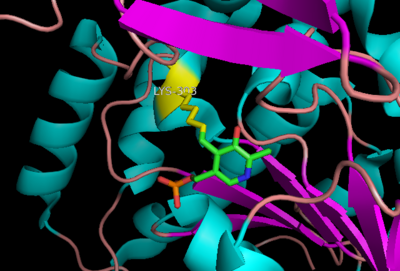DOPA decarboxylase
From Proteopedia
| Line 11: | Line 11: | ||
===The Aspartate Aminotransferase Family=== | ===The Aspartate Aminotransferase Family=== | ||
| - | This family of PLP-dependent enzymes is also referred to as '''fold-type I''', with aspartate aminotransferase serving as the prototype. [[image:aspartate_aminotransferase.jpg|thumb|left|200px|'''aspartate aminotransferase''']] It is the most common structure of the five classes of PLP-dependent enzymes. This fold it is found in a variety of aminotransferases and decarboxylases, amongst them '''DOPA decarboxylase'''. PLP-dependent enzymes belonging to this family are catalytically active as homodimers and share a common, well-characterized structure, despite low-sequence identity. Each subunit has a '''large domain''' and a '''small domain'''. The central feature of the large domain is a '''seven-stranded β sheet'''. The small domain has either a three or four-stranded β sheet that is surrounded by helices on one side. The cofactor PLP is covalently attached to a lysine residue in the large domain and is anchored in a way that allows the aromatic ring of PLP to pack against neighboring β strands. The active site is located in a cleft between the two domains at the interface between the two subunits. ''Thus, enzymes of fold-type I have residues from both domains and both subunits involved in PLP-binding.'' | + | This family of PLP-dependent enzymes is also referred to as '''fold-type I''', with aspartate aminotransferase serving as the prototype. [[image:aspartate_aminotransferase.jpg|thumb|left|200px|'''aspartate aminotransferase''']] It is the most common structure of the five classes of PLP-dependent enzymes. This fold it is found in a variety of aminotransferases and decarboxylases, amongst them '''DOPA decarboxylase'''. PLP-dependent enzymes belonging to this family are catalytically active as homodimers and share a common, well-characterized structure, despite low-sequence identity. Each subunit has a '''large domain''' and a '''small domain'''. The central feature of the large domain is a '''seven-stranded β sheet'''. The small domain has either a three or four-stranded β sheet that is surrounded by helices on one side. The cofactor PLP is covalently attached to a lysine residue in the large domain and is anchored in a way that allows the aromatic ring of PLP to pack against neighboring β strands. The active site is located in a cleft between the two domains at the interface between the two subunits. '''''Thus, enzymes of fold-type I have residues from both domains and both subunits involved in PLP-binding.''''' |
[[image:dopastructure.png|thumb|left|400px|'''large domain, small domain, and N-terminal domain''']] [[image:plp bound.png|thumb|right|400px|'''Schiff base linkage of PLP to Lys303 in the active site''']] | [[image:dopastructure.png|thumb|left|400px|'''large domain, small domain, and N-terminal domain''']] [[image:plp bound.png|thumb|right|400px|'''Schiff base linkage of PLP to Lys303 in the active site''']] | ||
===DOPA decarboxylase=== | ===DOPA decarboxylase=== | ||
Revision as of 18:35, 24 June 2011
Contents |
Introduction
| |||||||||
| 1js3, resolution 2.25Å () | |||||||||
|---|---|---|---|---|---|---|---|---|---|
| Ligands: | , , | ||||||||
| Activity: | Aromatic-L-amino-acid decarboxylase, with EC number 4.1.1.28 | ||||||||
| Related: | 1js6 | ||||||||
| |||||||||
| |||||||||
| Resources: | FirstGlance, OCA, RCSB, PDBsum | ||||||||
| Coordinates: | save as pdb, mmCIF, xml | ||||||||
DOPA decarboxylase is responsible for the synthesis of dopamine and serotonin from L-DOPA and L-5-hydroxytryptophan, respectively. Due to its role in neurotransmitter synthesis, DOPA decarboxylase has been implicated in Parkinson's disease, a disease thought to be the result of the degeneration of dopamine-producing cells in the brain. Currently, treatment for the disease is aimed at DOPA decarboxylase inhibition. Since dopamine cannot cross the blood-brain barrier, it cannot be used to directly treat Parkinson's disease. Thus, exogenously administered L-DOPA is the primary treatment for patients suffering from this neurodegenerative disease. Unfortunately, DOPA decarboxylase rapidly converts L-DOPA to dopamine in the blood stream, with only a small percentage reaching the brain. By inhibiting the enzyme, greater amounts of exogenously administered L-DOPA can reach the brain, where it can then be converted to dopamine. [2]
PLP-Dependent Enzymes
Overview
Pyridoxal-5'-phosphate (PLP), the biologically active phosphorylated derivative of vitamin B6, is a versatile and abundant cofactor to a variety of enzymes in all organisms. Almost all PLP-dependet enzymes function in pathways associated with amino compounds, primarily amino acid metabolism. The reactions carried out by these enzymes include transamination, decarboxylation', deamination, racemization, aldol cleavage reactions, and eliminations and replacements at the β and γ atoms of amino acid side chains. The versatility of this superfamily of enzymes can be attributed to the ability of PLP to covalently bind the substrate and then function as an electrophilic catalyst. In spite of the functional variety of these enzymes, there exist only five structural classes: the aspartate amino transferase family, the tryptophan synthase β family, the alanine racemase family, the D-amino acid family, and the glycogen phosphorylase family. [3] [1]The Aspartate Aminotransferase Family
This family of PLP-dependent enzymes is also referred to as fold-type I, with aspartate aminotransferase serving as the prototype.DOPA decarboxylase
DOPA decarboxylase is a homodimeric enzyme, with each monomer composed of three distinct domains. The large domain contains the PLP binding site, and consists of a seven stranded mixed beta-sheet that is surrounded by eight alpha-helices, resulting in a typical α/β fold. The C-terminal domain is comprised of a four-stranded anti-parallel beta-sheet that has three alpha-helices packed against the face opposite to the large domain. Although the aforementioned domains exist in all members of this family of PLP-dependent enzymes, including bacterial ornithine decarboxylase (OrnDC) and dialkylglycine decarboxylase (DGD), the is unique to DOPA decarboxylase, and is a representative case of domain swapping. This domain is composed of two parallel helices linked by an extended strand, which essentially lies like a flap over the second subunit. The N-terminal domain of one monomer packs on top of the other monomer, resulting in an extended dimer interface, and thus it is most likely stable only in the dimeric form of the enzyme.
Function
The Active Site
The active site of DOPA decarboxylase is located in a cleft at the between the two subunits of the dimer, like all PLP-dependent enzymes of the aspartate aminotransferase family. Since it is at the interface, residues from both domains and both subunits are involved in cofactor binding, although the active site is composed of residues mainly from one monomer. The is composed of several key residues. serves to bind PLP via a Schiff base linkage. As well, a salt bridge exists between the carboxyl group of and a pyridine nitrogen of PLP to further stabilize intermediates. The binds to the enzyme by forming a hydrazone linkage
Substrate Binding
Classification
SCOP
DOPA decarboxylase is classified in the following manner using SCOP:
- Class: alpha and beta proteins (α/β)
- Fold: PLP-dependent transferase-like
- Superfamily: PLP-dependent transferases
- Family: Pyridoxal-dependent decarboxylase
- Domain: DOPA decarboxylase
CATH
DOPA decarboxylase is classified in the following manner using CATH:
- large domain
- Class: alpha beta
- Architecture: 3-layer sandwich
- Topology: Aspartate aminotransferase
- small domain
- Class: alpha beta
- Architecture: alpha-beta complex
- Topology: Aspartate aminotransferase
- N-terminal domain
- Class: mainly alpha
- Architecture: up-down bundle
- Topology: dopa decarboxylase
3D structures of DOPA decarboxylase
3k40 – DDC – Drosophila melanogaster
1js3 – pDDC + inhibitor – pig
1js6 - pDDC
References
- ↑ 1.0 1.1 Schneider G, Kack H, Lindqvist Y. The manifold of vitamin B6 dependent enzymes. Structure. 2000 Jan 15;8(1):R1-6. PMID:10673430
- ↑ Burkhard P, Dominici P, Borri-Voltattorni C, Jansonius JN, Malashkevich VN. Structural insight into Parkinson's disease treatment from drug-inhibited DOPA decarboxylase. Nat Struct Biol. 2001 Nov;8(11):963-7. PMID:11685243 doi:http://dx.doi.org/10.1038/nsb1101-963
- ↑ Percudani R, Peracchi A. A genomic overview of pyridoxal-phosphate-dependent enzymes. EMBO Rep. 2003 Sep;4(9):850-4. PMID:12949584 doi:http://dx.doi.org/10.1038/sj.embor.embor914
Proteopedia Page Contributors and Editors (what is this?)
Brittany Todd, Michal Harel, David Canner, Alexander Berchansky, Brian Hernandez







